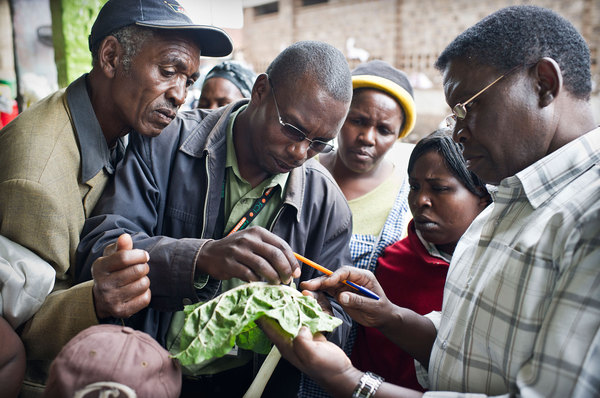Farmers in Malawi fund first purpose-built permanent plant clinic to fight pests and diseases
A group of farmers in Ntcheu district, Central Malawi, have clubbed together to fund the first purpose-built permanent plant clinic to help fight a range of crop-devastating pests and diseases that threaten their livelihoods and food security. Pengapenga Plant Clinic, which previously operated under a tree in the market place, is now providing a more…
Plantwise Initiative Equips Farmers with Knowledge in Zambia
Article by Dorcas Kabuya Chaaba- NAIS A small-scale farmer in Chilanga District, Moses Banda has seriously taken up vegetable production. Mr Banda commends Government for its continued support in assisting farmers in addressing crop problems and how best to control them organically. “My vegetables always had holes due to Sefasefa (Diamond Back Moth) and all…
Healing Plants to Feed a Nation
Growing up in a small village in Western Kenya, I often accompanied my mother and other village women on customary weeding expeditions. Whenever we came across sick plants in the fields—which was all too often—my mother would instruct me to pull them out and cast them aside. I did as she asked, but wondered to…
Could Food Insecure Africa Have Found a Saviour in Farming God’s Way?
Proponents term it the long awaited messiah that food-insecure Africa has been yearning for! ‘Farming God’s way’ promises to end fertilizer woes of resource-poor farmers in the continent by providing a cheaper and less labour intensive farming method. Food security remains the number one major challenge that citizens across the African continent contend with. While…
Herbicide Resistance Gene In Black-Grass and Rye-Grass Identified
BBSRC (Biotechnology and Biological Sciences Research Council) and Syngenta funded scientists at the University of York and University of Durham have discovered a gene called AmGSTF1 that plays a key role in controlling multiple herbicide resistance in black-grass (Alopecurus myosuroides) and annual rye-grass (Lolium rigidum). Now the gene that confers resistance has been identified, it…
Black Rot Disease Hits Uganda
Vegetable farmers in the Kayunga and Mukono districts of Uganda are reporting crop losses due to black rot disease. One farmer, Twaha Kahooza of Kyampisi village, Kayunga Sub-county, says he had planted four acres of cabbages and was expecting about Shs18m (about £4,500 or US$7,000) from the harvest, however he only managed to get Shs5m…
Maize Lethal Necrosis Disease Spreads To Uganda
Maize Lethal Necrosis disease, which was first reported in Kenya and Tanzania, has now spread to Uganda, raising concerns for food security in the country. The Ministry of Agriculture has warned that Maize Lethal Necrosis has been reported in districts in eastern Uganda, including Busia and Tororo. A spokesman for the Agriculture Research Organisation, Robert…
Monitoring and Management of Desert Locusts in Africa
The United Nations Food and Agriculture Organisation (FAO) has this month warned that Desert Locust (Schistocerca gregaria) swarms are invading cropping areas of northern Sudan. The swarms originated from winter breeding areas on the Red Sea coastal plains and subcoastal areas in northeast Sudan and southeast Egypt. The situation requires close monitoring as more swarms are…
New Type of Invasive Whitefly Recorded In South Africa
A species of whitefly that transmits cassava mosaic virus has been detected in South Africa for the first time. The whitefly, Bemisia tabaci is a cryptic species complex containing some important agricultural pests and virus vectors. The term ‘cryptic species complex’ means that Bemisia tabaci is considered to be a complex of at least 24 different…
Parasitic Witchweed defeated in Kenya
Striga, a parasitic weed (also known as Witchweed,) has long been a problem in African nations; causing farmers to lose billions of dollars’ worth of crops annually. To make matters worse, the weed flourishes in conditions that characterise that of poor farming communities (small plots, mono-cropping, lack of oxen and natural manure and lack of…


